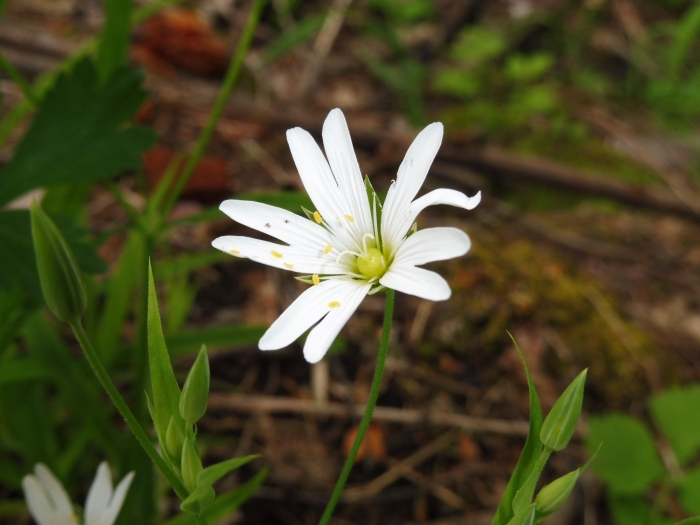Greater Stitchwort
(Rabelera holostea)
Greater Stitchwort (Rabelera holostea)
/
/

JS
CC BY 4.0
Image By:
JS
Recorded By:
Copyright:
CC BY 4.0
Copyright Notice:
Photo by: JS | License Type: CC BY 4.0 | License URL: http://creativecommons.org/licenses/by/4.0/ | Rights Holder: JS | Publisher: iNaturalist | Date Created: 2020-05-28T16:52:06-07:00 |














Estimated Native Range
Summary
Rabelera holostea, commonly known as Greater Stitchwort or Greater Starwort, is a perennial herb that is native to a variety of habitats including deciduous woodlands, hedgerows, meadows, and grassy banks across Europe, as well as the British Isles. It typically grows up to 24 inches tall and features slender, green stems with long, narrow, lanceolate leaves. The plant is well-known for its delicate white flowers, which bloom from April to June. Each flower is about 1 inch across, with five deeply notched petals that give the appearance of ten petals. These flowers are quite showy and can create a carpet of white in their natural setting during the flowering season.
Greater Stitchwort is valued for its charming flowers and its ability to naturalize in suitable garden conditions. It is sometimes used in informal garden settings, cottage gardens, and for naturalizing in wildflower meadows. It prefers partial shade but can tolerate full sun if the soil remains moist. The plant thrives in well-drained soil with consistent moisture and can be propagated by seed or division in the spring or fall. While it is not commonly afflicted by diseases, it can be susceptible to rust. Greater Stitchwort is not known for being particularly invasive, but it can spread in favorable conditions, so gardeners should monitor its growth.CC BY-SA 4.0
Greater Stitchwort is valued for its charming flowers and its ability to naturalize in suitable garden conditions. It is sometimes used in informal garden settings, cottage gardens, and for naturalizing in wildflower meadows. It prefers partial shade but can tolerate full sun if the soil remains moist. The plant thrives in well-drained soil with consistent moisture and can be propagated by seed or division in the spring or fall. While it is not commonly afflicted by diseases, it can be susceptible to rust. Greater Stitchwort is not known for being particularly invasive, but it can spread in favorable conditions, so gardeners should monitor its growth.CC BY-SA 4.0
Plant Description
- Plant Type: Herb
- Height: 1.5-2.5 feet
- Width: 1-1.5 feet
- Growth Rate: Moderate
- Flower Color: White
- Flowering Season: Spring, Summer
- Leaf Retention: Deciduous
Growth Requirements
- Sun: Full Sun, Part Shade
- Water: Medium
- Drainage: Medium
Common Uses
Bee Garden, Border Plant, Butterfly Garden, Low Maintenance
Natural Habitat
native to a variety of habitats including deciduous woodlands, hedgerows, meadows, and grassy banks across Europe, as well as the British Isles
Other Names
Common Names: Greater Stitchwort, Wedding Cakes, Echte Sternmiere
Scientific Names: , Rabelera holostea, Alsine holostea, Alsine scabra, Cerastium holosteum, Stellaria caespitosa, Stellaria caespitosa, Stellaria cantalica, Stellaria ciliata, Stellaria connata
GBIF Accepted Name: